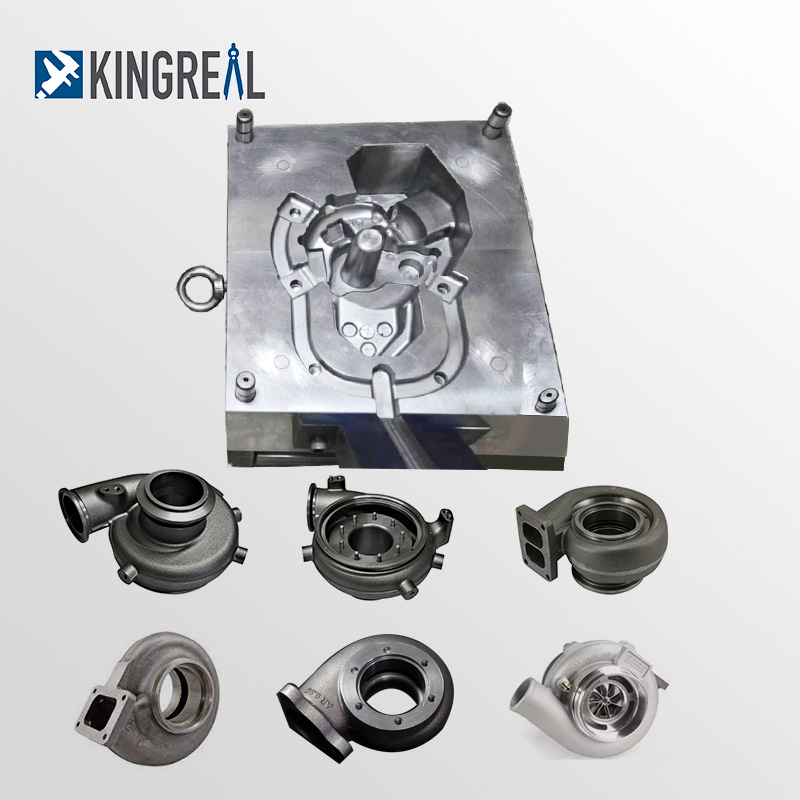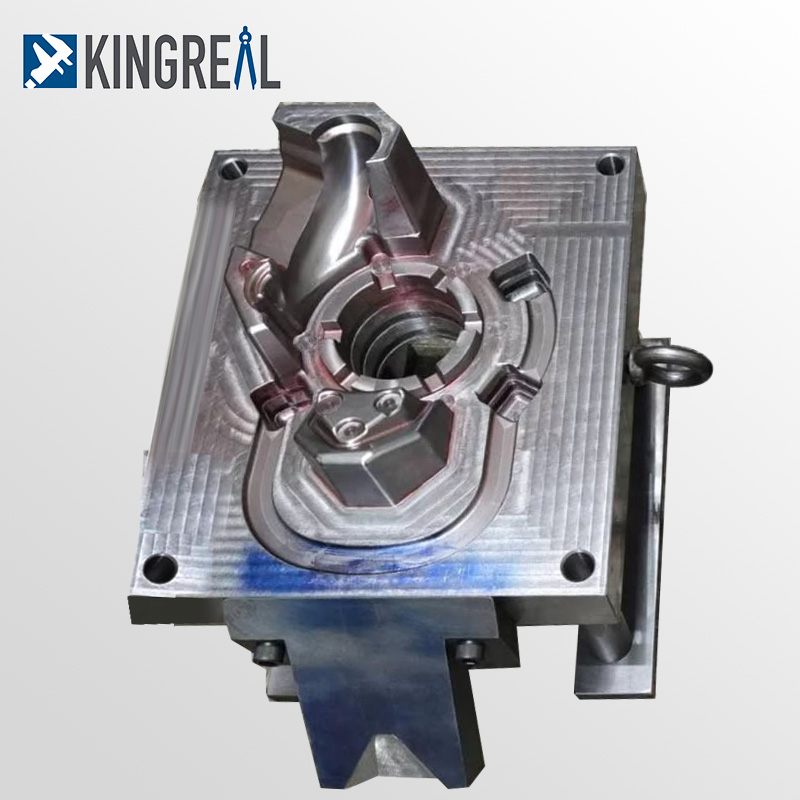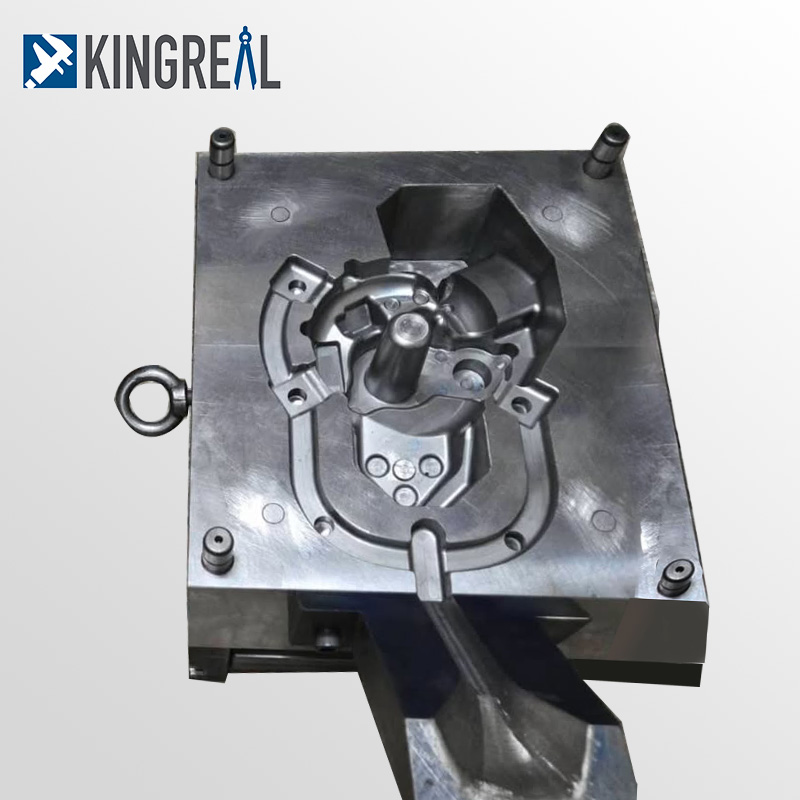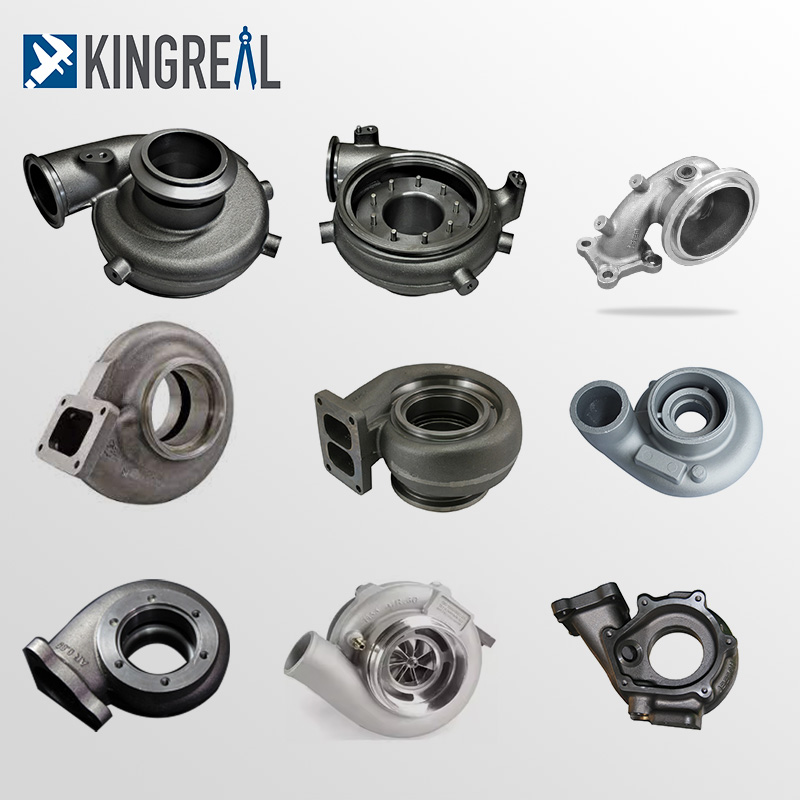
KINGREAL UNIVERSAL IND., LTD
Phone
+86-13702855825| 1 | Filling Stage |
| 2 | Pressure Maintaining Stage |
| 3 | Cooling stage |
| 4 | Demoulding stage |
The permanent mold casting process of plastic parts mainly includes four stages: filling, holding pressure, cooling and demoulding, which directly determine the turbocharger compressor housing molding quality of products, and these four stages are a complete and continuous process.
1. Filling stage
Filling is the first step in the whole injection cycle, and the time starts from the closing of the automotive exterior trim molds to the filling of the turbocharger compressor housing mold cavity to about 95%. Theoretically, the shorter the filling time, the higher the molding efficiency, but in practice, the permanent mold casting time or injection speed is restricted by many conditions.
High speed filling. The shear rate is high when filling at high speed, and the viscosity of plastic decreases due to shear thinning, which reduces the overall flow resistance; The local viscous heating effect will also make the cured layer thinner. Therefore, in the flow control stage, the filling behavior often depends on the volume to be filled. That is to say, in the flow control stage, due to high-speed filling, the shear thinning effect of melt is often great, but the cooling effect of thin wall is not obvious, so the effect of speed prevails.
Low speed filling. When low-speed filling is controlled by heat conduction, the shear rate is low, the local viscosity is high and the flow resistance is large. Due to the slow replenishment rate and slow flow of hot plastics, the heat conduction effect is obvious, and the heat is quickly taken away by the cold automotive exterior trim molds wall. Coupled with a small amount of viscous heating phenomenon, the cured layer is thicker, which further increases the flow resistance at the thinner wall.
Due to the fountain flow, the plastic polymer chain in front of the flow wave is arranged almost parallel to the flow front. Therefore, when two strands of plastic melt glue meet, the polymer chains on the contact surface are parallel to each other; In addition, the properties of the two strands of molten rubber are different (the residence time in the turbocharger compressor housing mold cavity is different, and the temperature and pressure are also different), which leads to the poor structural strength of the joint area of molten rubber. When the parts are placed at an appropriate angle under light and observed with naked eyes, it can be found that there are obvious joint lines, which is the formation mechanism of weld marks. Weld marks not only affect the appearance of plastic parts, but also cause stress concentration due to the looseness of microstructure, which reduces the strength of this part and leads to fracture.
Generally speaking, the strength of weld lines generated by welding in high temperature area is better, because under high temperature conditions, polymer chains have better activity and can penetrate each other. In addition, the temperatures of the two melts in high temperature area are close, and the thermal properties of the melts are almost the same, which increases the strength of the welded area. On the contrary, in low temperature area, the welding strength is poor.



2. Pressure maintaining stage
The function of holding pressure stage is to continuously apply pressure, compact the melt and increase the density of plastic (densification) to compensate the shrinkage behavior of plastic. In the process of holding pressure, the back pressure is high because the turbocharger compressor housing mold cavity has been filled with plastic. In the process of pressure-maintaining compaction, the screw of turbocharger compressor housing molding machine can only move slightly forward slowly, and the flow speed of plastic is also slow, which is called pressure-maintaining flow. In the pressure maintaining stage, the plastic is cooled and solidified by the automotive exterior trim molds wall, and the viscosity of the melt increases rapidly, so the resistance in the automotive exterior trim molds cavity is great. In the later stage of pressure maintaining, the density of materials continues to increase, and the plastic parts are gradually formed. The pressure maintaining stage will continue until the gate is solidified and sealed, at which time the cavity pressure reaches the highest value.
In the pressure-holding stage, because the pressure is quite high, the plastic is partially compressible. In the high pressure area, the plastic is denser and has higher density; In the area with low pressure, the plastic is loose and has low density, which causes the density distribution to change with location and time. In the process of holding pressure, the plastic flow rate is extremely low, and the flow no longer plays a leading role; Pressure is the main factor affecting the holding process. In the process of holding pressure, the plastic has filled the mold cavity, and the gradually solidified melt is used as the medium to transmit pressure. The pressure in the automotive exterior trim molds cavity is transferred to the surface of the turbocharger compressor housing mold wall by means of plastic, which tends to open the turbocharger compressor housing mold, so proper clamping force is needed to lock the automotive exterior trim molds. Under normal circumstances, the die expanding force will slightly open the die, which is helpful for the exhaust of the die; However, if the die expanding force is too large, it is easy to cause burrs, flash and even open the die. Therefore, when choosing an permanent mold casting machine, we should choose an turbocharger compressor housing molding machine with enough clamping force to prevent the automotive exterior trim molds from expanding and effectively maintain the pressure.
3. Cooling stage
The design of cooling system is very important in permanent mold casting. This is because the molded plastic products can only be cooled and solidified to a certain rigidity, and then the plastic products can be prevented from being deformed due to external force after demoulding. Because the cooling time accounts for about 70% ~ 80% of the whole permanent mold casting cycle, a well-designed cooling system can greatly shorten the turbocharger compressor housing molding time, improve the injection productivity and reduce the cost. Improper design of cooling system will prolong the permanent mold casting time and increase the cost; Uneven cooling will further cause warping deformation of plastic products.
According to the experiment, the heat entering the automotive exterior trim molds from the melt is generally distributed in two parts, one part of which is 5% transferred to the atmosphere by radiation and convection, and the other 95% is transferred from the melt to the turbocharger compressor housing mold. Due to the effect of cooling water pipes, the heat of plastic products in the turbocharger compressor housing mold cavity is transferred to the cooling water pipes by heat conduction from the plastic in the automotive exterior trim molds cavity through the mold base, and then taken away by the cooling liquid through thermal convection. A small amount of heat that is not taken away by the cooling water continues to be conducted in the turbocharger compressor housing mold until it touches the outside and overflows into the air.
The molding cycle of permanent mold casting consists of closing time, filling time, holding time, cooling time and demoulding time. Among them, the cooling time accounts for the largest proportion, about 70% ~ 80%. Therefore, the cooling time will directly affect the turbocharger compressor housing molding cycle and output of plastic products. In the demoulding stage, the temperature of plastic products should be cooled to below the thermal deformation temperature of plastic products, so as to prevent the relaxation phenomenon of plastic products caused by residual stress or the warping and deformation caused by demoulding external force.
The factors affecting the cooling rate of products are: the design of plastic products. Mainly the wall thickness of plastic products. The greater the thickness of the product, the longer the cooling time. Generally speaking, the cooling time is directly proportional to the square of the thickness of plastic products, or directly proportional to the 1.6 power of the largest channel diameter. That is, the thickness of plastic products is doubled and the cooling time is increased by 4 times.
Die material and its cooling mode. Automotive exterior trim molds materials, including mold core, cavity material and mold base material, have great influence on cooling rate. The higher the thermal conductivity of the mold material, the better the effect of transferring heat from the plastic in unit time and the shorter the cooling time.
Configuration mode of cooling water pipes. The closer the cooling water pipes are to the turbocharger compressor housing mold cavity, the larger the pipe diameter and the more the number, the better the cooling effect and the shorter the cooling time.
Coolant flow. The greater the flow rate of cooling water (turbulence is generally better), the better the effect of cooling water taking away heat by thermal convection.
Properties of coolant. The viscosity and thermal conductivity of cooling liquid will also affect the thermal conductivity of the turbocharger compressor housing mold. The lower the viscosity of coolant, the higher the thermal conductivity, and the lower the temperature, the better the cooling effect.
Plastic selection. Plastic refers to the measurement of the speed at which plastic conducts heat from a hot place to a cold place. The higher the thermal conductivity of plastics, the better the heat conduction effect, or the lower the specific heat of plastics, the temperature is easy to change, so the heat is easy to dissipate, the heat conduction effect is better, and the required cooling time is shorter.
Setting of machining parameters. The higher the material temperature, the higher the automotive exterior trim molds temperature, the lower the ejection temperature and the longer the cooling time.
Design rules of cooling system:
The designed cooling channel should ensure the uniform and rapid cooling effect.
The purpose of designing the cooling system is to maintain proper and efficient cooling of the turbocharger compressor housing mold. Cooling holes should be of standard size to facilitate processing and assembly.
When designing the cooling system, the automotive exterior trim molds designer must determine the following design parameters according to the wall thickness and volume of plastic parts-the position and size of cooling holes, the length of holes, the types of holes, the configuration and connection of holes, and the flow rate and heat transfer properties of coolant.
4. Demoulding stage

Stripping is the last link in a permanent mold castingcycle. Although the product has been cold-set, demoulding still has a very important impact on the quality of the product. Improper demoulding method may lead to uneven stress on the product during demoulding and deformation of the product during ejection. There are two main ways of demoulding: ejector pin demoulding and stripper plate demoulding. When designing the automotive exterior trim molds, we should choose the appropriate demoulding method according to the structural characteristics of the product to ensure the quality of the product.
For the turbocharger compressor housing mold with ejector pin demoulding, the ejector pin should be set as evenly as possible, and the position should be selected at the place with the greatest demoulding resistance and the greatest strength and stiffness of plastic parts to avoid deformation and damage of plastic parts.
The stripper plate is generally used for demoulding deep-cavity thin-walled containers and transparent products that are not allowed to have traces of push rods. This mechanism is characterized by large and uniform demoulding force, stable movement and no obvious traces left.